Description
Blackberries, known scientifically as Rubus fruticosus, are perennial plants that belong to the Rosaceae family. Native to Europe and Asia, blackberry plants are typically thorny shrubs or vines, growing up to 3 meters in height. The leaves of the plant are compound with three to five leaflets arranged alternately on the stem. The flowers are white or pale pink and bloom in late spring to early summer. The fruit is a dark purple or black aggregate of drupelets.
Crop Details
Scientific Name: Rubus fruticosus
Common Names: blackberry, bramble (En); zarza (SP); murier (Fr); amora silvestre (Portuguese)

Blackberry bush

Fruit close-up

Thorns on blackberry stem

Fall foliage

Foliage and blossoms

Plants laden with fruit

Blackberry blossoms

Ripening fruits

Ripening blackberry fruit
Uses & Benefits
Blackberries can be consumed fresh or used in culinary applications such as pies, jams, jellies, desserts and wines. They are also processed into juice or dried for use in tea blends.
Nutritionally, blackberries offer high levels of antioxidants like anthocyanins which contribute to their deep color. They also provide dietary fiber, Vitamin C and K among other nutrients.
Varieties of BlackBerry
There exist several varieties of blackberries including trailing (Rubus ursinus), erect (Rubus argutus), semi-erect (Rubus allegheniensis) among others which differ based on size, taste profile and growth habit. Erect blackberries are bushes that support themselves, while the trailing blackberries have long canes that must be trellised for support.
Propagation
Basic Requirements
Blackberries prefer well-draining soils with a pH between 5.5-6.5 that is rich in organic matter. They require full sun exposure for optimal growth but can tolerate partial shade.
Planting is best done during early spring using either bare-root plants or potted plants which should be spaced about 4-10 feet apart depending on variety.
Growing from Seed
For semi-erect cultivars, space plants 5 to 6 feet apart. Space erect cultivars 3 feet apart. Space trailing varieties 5 to 8 feet apart. Space rows about 8 feet apart.
General Care & Maintenance
Pruning is essential for maintaining plant health by removing dead wood and thinning out crowded branches to improve air circulation and sunlight penetration. Regular watering is necessary especially during dry periods while mulching helps conserve soil moisture as well as suppress weeds.
Harvesting
Blackberries usually ripen over a period of two months with each bush producing several crops per season starting from the second year after planting although full production is reached after three years. Berries should be harvested when they have fully turned dark purple or black which indicates peak sweetness.
References
CABI Crop Protection Compendium. (2008). Rubus datasheet. Available at: http://www.cabi.org/cpc/datasheet/47977. [Accessed 06 November 14]. Paid subscription required.
Ellis, M. A. & Converse, R. (1991) Compendium of raspberry and blackberry diseases and insects. American Phytopathological Society Press. Fernandez, G. & Ballington, J. R. Growing blackberries in the home garden. North Carolina Cooperative Extension Service. Available at: http://www.ces.ncsu.edu/depts/hort/hil/pdf/ag-401.pdf. [Accessed 06 November 14]. Free to access.
Common Pests and Diseases
Diseases
Category : Fungal
Anthracnose
Elsinoe veneta

Close-up of Anthracnose lesions on Bristol black raspberry.
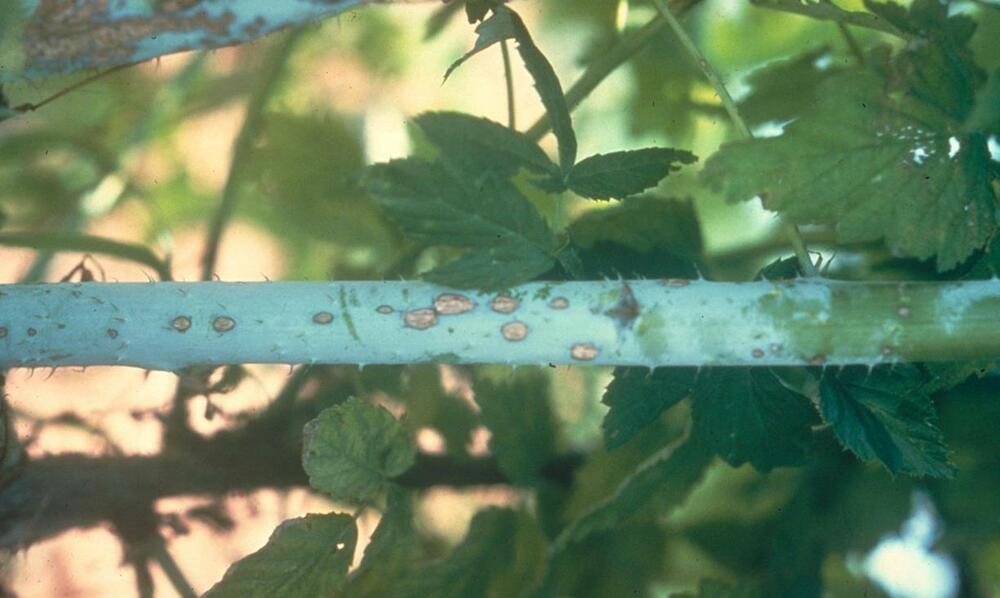
Anthracnose lesions on cane
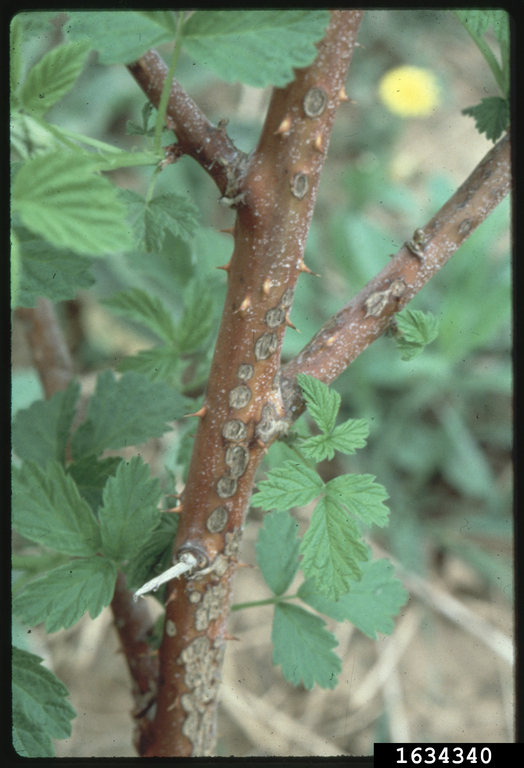
Anthracnose on Bristol black raspberry.
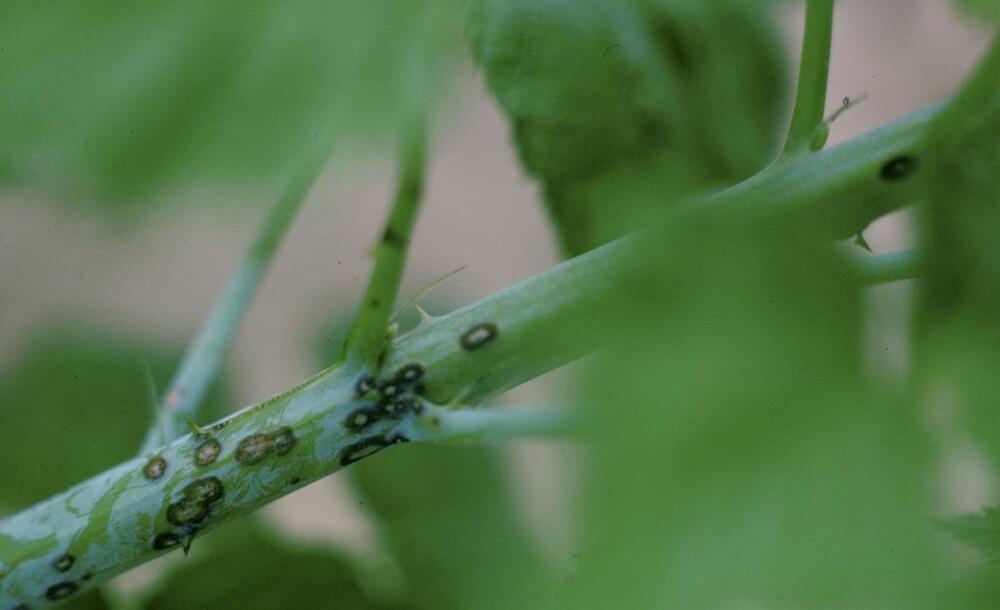
Anthracnose lesions on cane
Symptoms
Small purple or red circular lesions on canes which enlarge and develop a sunken gray, cracked center; margin of lesions become raised and purple; lesions coalesce to form large discolored areas; canes may eventually be girdled and die back.
Cause
Fungus
Comments
Management
Cultural practices for controlling the spread of disease in the home garden include: avoiding excessive applications of nitrogen fertilizers, keeping areas surrounding plants free from weeds, avoiding overhead irrigation and watering only during the day, ensuring the plants have adequate time to dry out in the afternoon; commercial growers may require the use of fungicides for large plantations.
Blackberry rosette (Double blossom)
Cercosporella rubi

Disease symptoms

Blackberry rosette symptom
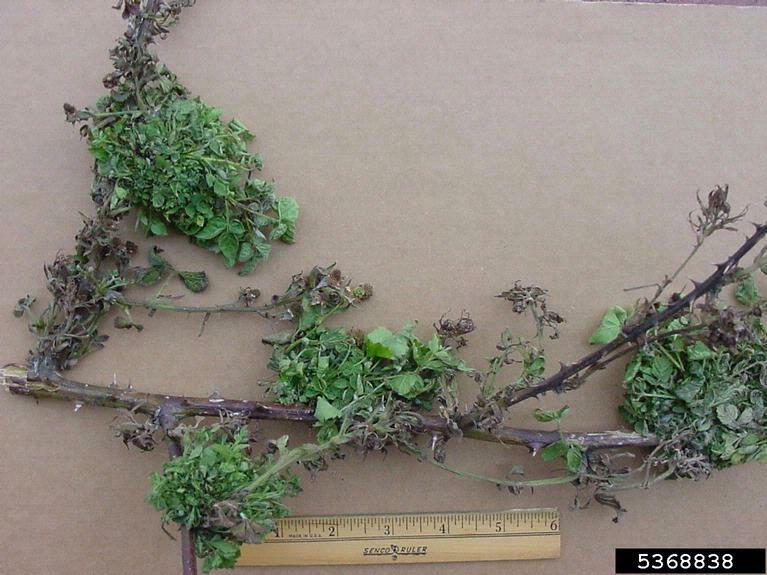
Proliferation of small, leafy shoots instead of normal shoot growth

Abnormal proliferations of blackberry shoot
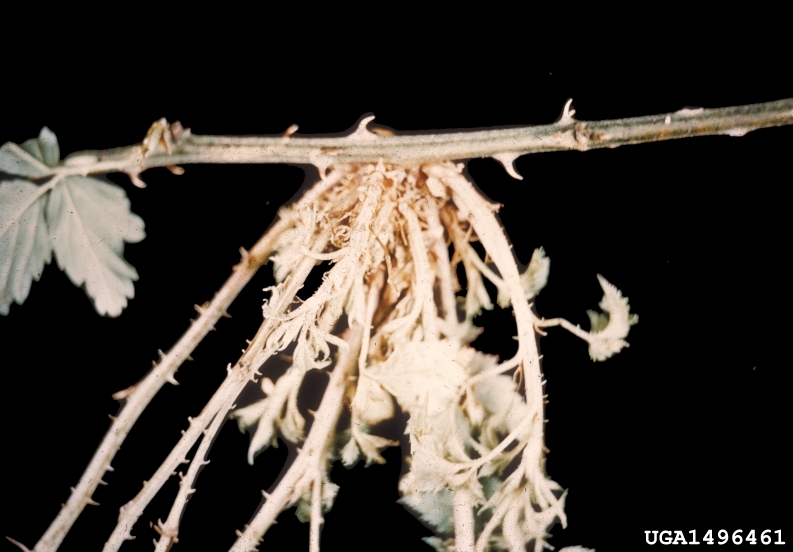
Cercosporella; Witches broom on Blackberry
Symptoms
Flowers with distorted petals and enlarged sepals which gives the appearance of a double flower; unopened flowers are enlarged and redder than normal; shoots may have abnormal proliferations; no fruit is produced on infected branches.
Cause
Fungus
Comments
Management
The most effective method of controlling the disease is the use of resistant blackberry varieties; if plants are already infected but disease is not yet severe then remove and destroy any abnormal blossom clusters; old canes should be removed and destroyed immediately following harvest; fungicide application may limit damage; disease can also be controlled by only harvesting berries in alternating years, completely destroying the above ground part of the plants in the years in between; the planting may be split in two so that there is a harvest of fruit each year while the other half is cut back.
Botrytis fruit rot
Botrytis cinerea

gray mold (Botrytis cinerea) mycelium with conidia

Rotting fruit covered with fungal growth of Botrytis cinerea (right) and Rhizopus sp. (left)
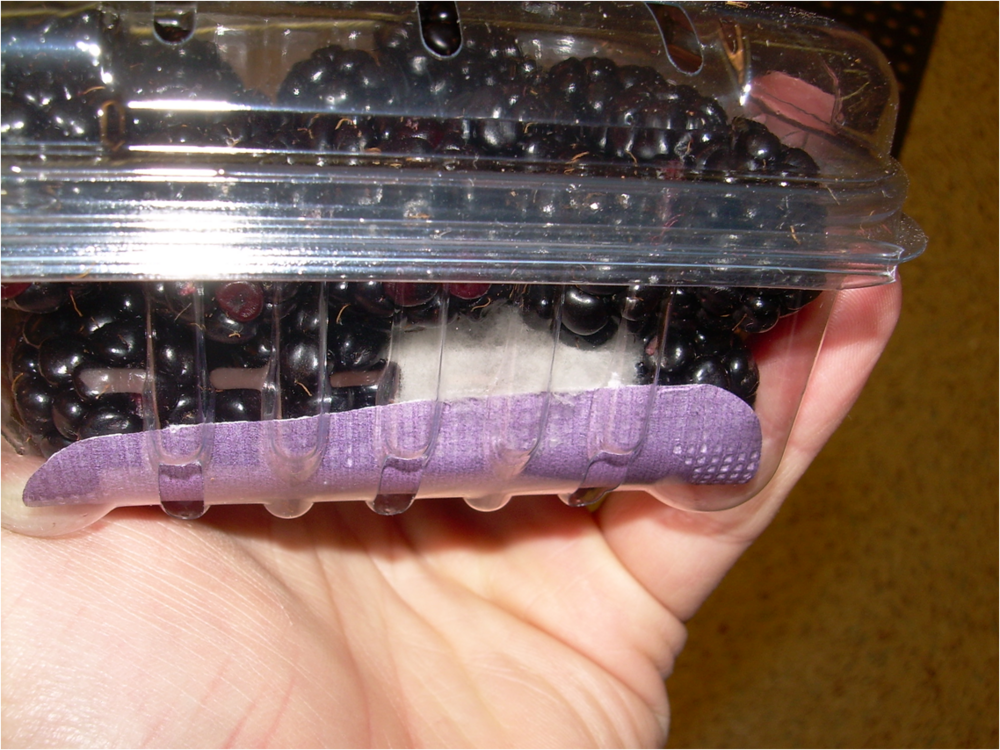
Botrytis mycelium on blackberry fruit
Symptoms
Canes are bleached in appearance and develop flattened masses of black fungal fruiting bodies where grey mycelium and spores develop; flowers may become infected and become blighted by the fungus; infected drupelets on the fruit may develop a watery rot which is replaced by grayish brown fungal structures; if berries are left on the vines they become mummified.
Cause
Fungi
Comments
Management
Promote air circulation around vines by using trellises or training the vines; avoid over fertilizing plants; protective fungicides can be used to control the disease and should be applied at intervals of 7-14 days from early bloom right through to harvest.
Cane and Leaf Rust
Kuehneola uredinis

Kuehneola uredinis rust on the stem

Rust symptoms on stem

cane and leaf rust (Kuehneola uredinis) spore mass on cane
Symptoms
The infected plant cane and leaves exhibit the small, lemon-yellow pustules. As the disease progress infected cane will show cracking and drying, whereas the leaves become spotted and dries off.
Cause
Fungus
Comments
Management
Prune out and burn infected cane and leaves.
Orange rust
Gymnoconia peckiana
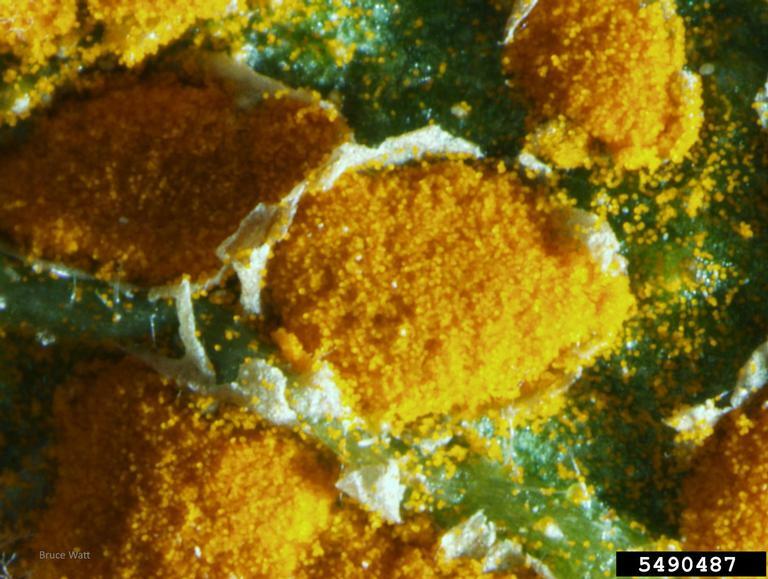
Orange aecia bordered by white ruptured peridium.

Orange rust fruiting bodies (Aecia) on lower side of leaf

Orange rust infected blackberry leaves

Numerous bright orange pustules developing on the undersides of leaves.
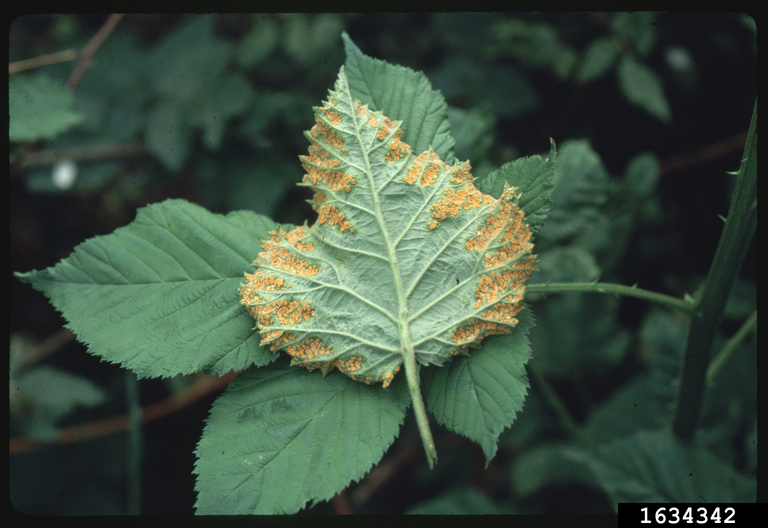
Blackberry orange rust

Healthy blackberry (left) compared with blackberry infected with orange rust (right)

Infected foliage covered with aecial pustules

Orange rust infected leaves

Orange rust pustules
Symptoms
New growth is weak and spindly and lacks spines; leaves are stunted and distorted and are pale in color; waxy pustules develop on leaf undersides and turn orange and powdery; infected leaves eventually drop from the plant.
Cause
Fungus
Comments
Management
Infected plants should be removed in entirety; prune and burn fruiting canes after harvest; improve air circulation around foliage by pruning and trellising vines; spread of rust can be minimized by applying foliar fungicides wen the orange spores are being produced; if well managed, the disease is not usually serious.
Powdery mildew
Podosphaera macularis
Symptoms
Light green chlorotic patches on foliage which later develops into powdery gray patches; leaves may be twisted or distorted; if infection is severe then shoots may become spindly with small leaves which cup upwards.
Cause
Fungus
Comments
Management
If powdery mildew is known to be a problem in a particular area then avoid planting susceptible varieties; varieties bred in the US state of Arkanasas, such as Navaho, Apache, and Arapaho, are known to be quite resistant to powdery mildew.
Category : Bacterial
Crown gall
Agrobacterium tumefaciens

Crown gall on cane

Crown gall infesting cane

Stand dieback due to crown gall

Crown gall on Munger black raspberry.
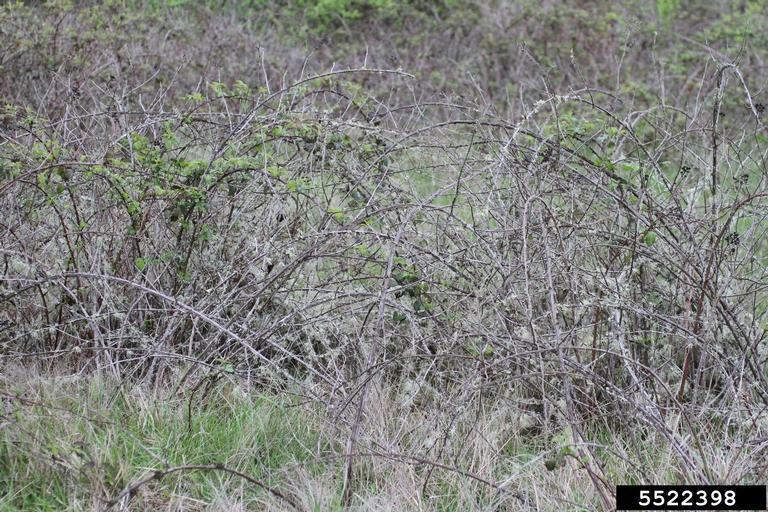
Stand dieback from crown gall

Gall on blackberry root system
Symptoms
Galls on canes and branches above ground or on root system; galls have a rough surface and a spongy texture; galls may darken and develop cracks as they mature; galls may have little or no effect on growth but can cause a reduction in vigor and death of plants.
Cause
Bacterium
Comments
Management
Avoid planting in areas known to have been affected by crown gall for a period of a least three years; if an infected plant is found, destroy it immediately; a biological control agent called Galltron is available for use in blackberries which contains a nonpathogenic strain of Agrobacterium which is antagonistic to the bacterium which causes crown gall; roots of new plantings are dipped in the substance prior to planting to protect them.
Pests
Category : Insects
Japanese beetle
Popillia japonica

Beetle feeding on foliage

Japanese beetles and damage

Adult beetles feeding on foliage
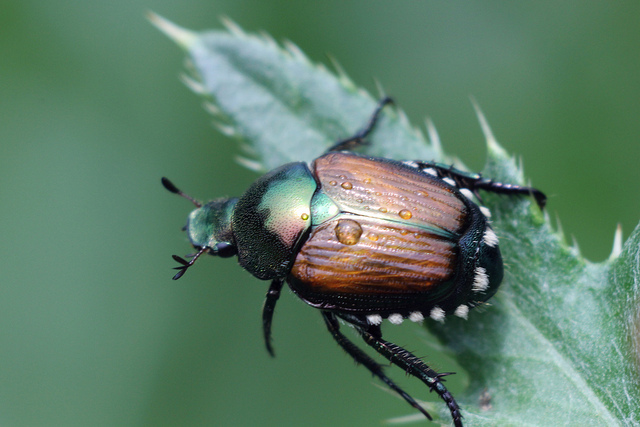
Japanese beetle

Japanese beetles mating and feeding on raspberry leaves and fruit
Symptoms
Leaves skeletonized (only veins remaining); flowers and buds damaged; plant damage may be extensive; adult insect is a metallic green-bronze beetle with tufts of white hair protruding from under wing covers on each side of the body; adult beetles are approximately 13 mm in length; larvae are cream-white grubs which develop in the soil.
Cause
Insect
Comments
Management
If beetles were a problem in the previous year, use floating row covers to protect plants or spray kaolin clay; adult beetles can be hand picked from plants and destroyed by placing in soapy water; parasitic nematodes can be applied to soil to reduce the number of overwintering grubs; insecticidal soaps or neem oil can help reduce beetle populations.
Leafrollers (e.g. Omnivorous leafroller)
Platynota stultana
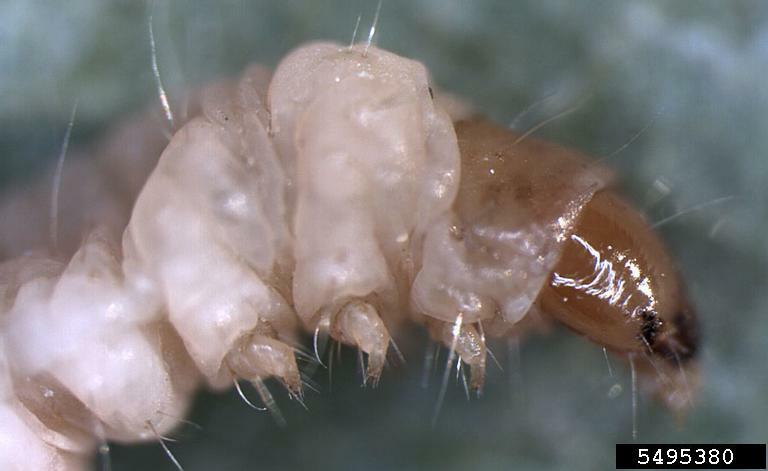
Leafroller larvae

Adult insect

Omnivorous leafroller (Platynota stultana)
Symptoms
Leaves of plant rolled and tied together with silk webbing; feeding damage to rolled leaves; defoliation of plant; silk webbing may also be present on fruits and fruits may have substantial scarring from feeding damage; larvae wriggle vigorously when disturbed and may drop from plant on a silken thread.
Cause
Insect
Comments
Management
Monitor plants regularly for signs of infestation; remove weeds from plant bases as they can act as hosts for leafrollers; avoid planting pepper in areas where sugarbeet or alfalfa are grown nearby; Bacillus thuringiensis or Entrust SC may be applied to control insects on organically grown plants; apply sprays carefully to ensure that treatment reaches inside rolled leaves.
Rednecked cane borer
Agrilus ruficollis

Rednecked cane borer (Agrilus ruficollis) adult

Galls on canes
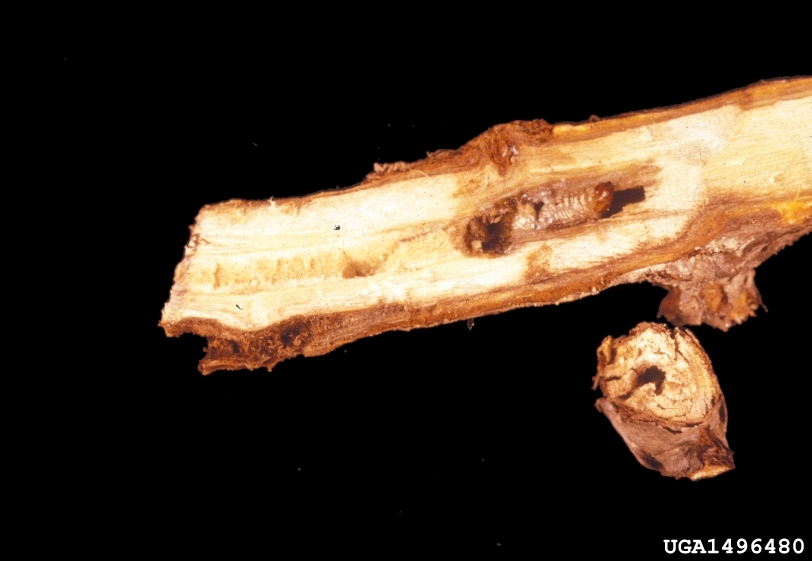
Rednecked cane borers feeding inside Blackberry cane

Tunnel in cane made by rednecked cane borer

Rednecked cane borer adult

Redneck cane borer mating
Symptoms
Galls on canes which are usually 2.5-7.6 cm (1- 3 in) in length; canes may die over winter above the galls; bud break may be delayed the following spring; canes with galls often do not produce fruit; adult insect is a slender, metallic black beetle; larvae are white, flat-headed grubs.
Cause
Insect
Comments
Management
Canes with galls should be pruned out and burned or buried to destroy overwintering larvae; remove any wild brambles nearby which may act as a reservoir for cane borer populations; if chemical treatment is required (generally if more than 5% of canes are affected) then it should be applied after bloom to limit damage to bees.





















































